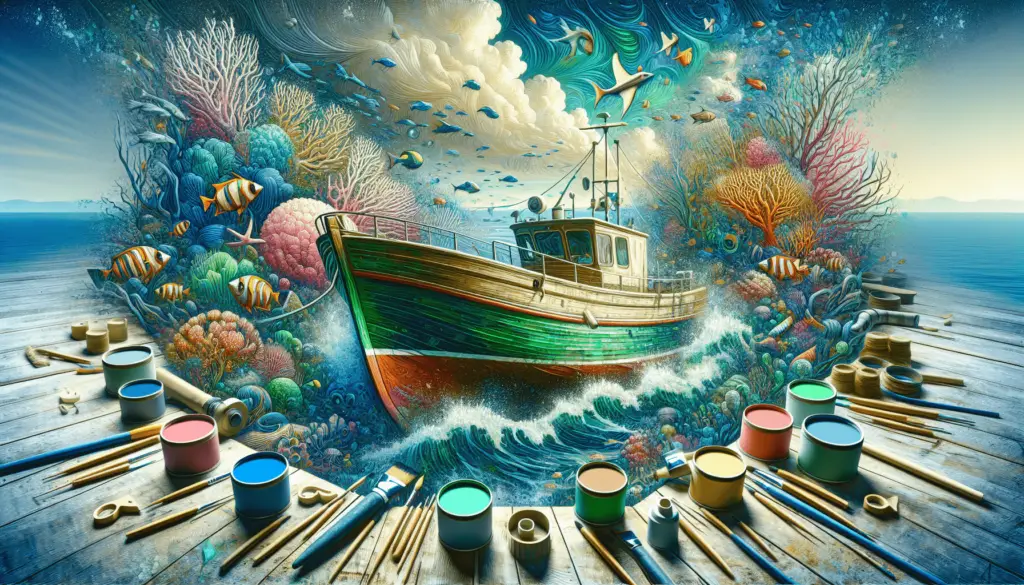In a world increasingly aware of its environmental impact, you might find yourself asking how you can minimize your carbon footprint when it comes to boat repair and maintenance. As a responsible boat owner, this essential guide on “How To Choose Environmentally Friendly Materials For Boat Repairs And Maintenance” will walk you through selecting materials that not only serve your boat’s needs efficiently but also play a role in conserving the environment. This informative piece will equip you with the knowledge you need to make your marine adventure eco-friendly.
Understanding the environmental impact of traditional boat repair materials
Navigating through the vast world of boating can be exciting. However, it is crucial to be aware of the significant environmental impact that some traditional boat repair materials have.
Highlighting the environmental damage caused by traditional materials
Traditional boat repair materials like fiberglass, toxic paints, and oil-based products can cause tremendous harm to the environment. They can lead to leaching of harmful materials into the water bodies, damaging aquatic ecosystems, declining fish populations, and contaminating drinking water sources. The waste generated from boat repairs can also fill up landfills, contributing to soil pollution.
Comparing the sustainability of different materials
Ideally, sustainable materials should have a low environmental impact in terms of energy consumption, waste production, and carbon footprint. When considering the sustainability of different materials for boat repair, factors such as their production process, transportation, usage, and disposal need to be considered. For instance, synthetic materials such as plastic or rubber might have a lower initial impact, but their non-biodegradability makes them less sustainable in the long run.
The role of boat maintenance in environmental degradation
Not often do we think about the environment when it comes to boat maintenance. But it is a contributor to the total environmental footprint of boating. Regular boat maintenance often involves the use of harmful chemicals and non-biodegradable materials. By accumulating over time, these can have significant negative impacts on the environment such as water and soil pollution, and harm to aquatic organisms.
Examining the environmental footprint of the boating industry
The environmental footprint of the boating industry is substantial and multifaceted. The impact starts from the raw materials used for boat construction and continues through their production, distribution, usage, and finally, disposal.
Raw material acquisition impact
The extraction of raw materials for building and repairing boats can have a significant environmental footprint. This includes the cutting of trees for wood, mining for metal ores, and the production of synthetic materials. Many of these procedures result in massive land degradation, loss of biodiversity, and air and water pollution.
Production energy used
Boat manufacturing processes can be energy-intensive, especially when dealing with synthetic materials. Producing fiberglass, plastics, and metals require a high amount of energy, most of which comes from the burning of fossil fuels. This leads to greenhouse gas emissions, contributing to global warming.
Impact of transport and distribution
The transportation and distribution of boats and their repair materials contribute to the overall carbon footprint of the boating industry. They involve the use of large cargo vehicles, ships, and airplanes, which consume significant amounts of fossil fuels.
Post-use effects
The last stage, but certainly not the least important, is the disposal of old boats and used repair materials. Incorrect disposal can release toxic substances into the environment. In addition, many boats are often left to decay in water bodies leading to different forms of pollution.

Types of eco-friendly materials for boat repairs
With growing environmental consciousness, a number of eco-friendly materials are available for boat repairs.
Introduction to biodegradable materials
Biodegradable materials, as the name implies, break down naturally in the environment. This attribute makes them an excellent choice for boat repairs. Some examples include natural wood, cotton, hemp, and bamboo.
Exploring the use of recycled materials
Recycled materials make another brilliant environmentally-friendly alternative. These include recycled metals and plastics, which have a lower carbon footprint as their production does not require fresh raw materials.
Understanding plant-based eco-composites
Plant-based eco-composites, derived from natural fibers and resins, serve as sustainable alternatives to synthetic materials. Some of these include flax, hemp, and cork. They are highly sustainable and produce lower carbon emissions.
Specific eco-friendly materials for boat repairs
Let’s dive deeper into some particular eco-friendly materials that can be used during boat repair.
Flax fiber for hull repair
The use of flax fiber is becoming increasingly popular in hull repair. This material is strong, lightweight, and capable of withstanding harsh marine environments. Plus, it’s entirely biodegradable.
Cork for deck surfaces
If you are looking for an eco-friendly alternative for your deck surface, cork is your answer. It is non-slip, comfortable underfoot, and resilient to sea water. In addition, it is easy to install and maintain.
Bamboo for interior fixtures
Bamboo is a highly sustainable resource that can replace conventional woods for interior fixtures. It grows rapidly, absorbs more carbon dioxide than most trees, and requires less water and no pesticides.
Recycled metals for engine components
Recycled metals like aluminum and steel can be used to replace engine components in a more sustainable manner. They not only reduce waste but also save energy that would otherwise be used to produce new metals.

Processes involved in choosing eco-friendly materials for boat repair
To follow a green approach to boat repairs, it is essential to take into account certain considerations.
Identifying the materials needed
The first step is to identify the materials needed for repair. Understanding their purpose will enable you to make informed decisions on selecting their eco-friendly alternatives.
Assessing the environmental implications of each material
Once you know what materials you need, assess their environmental impact. This can include their production process, usage, and disposal methods. Each has it’s own implication, and understanding these will help you make sustainable choices.
Checking for availability and affordability
Lastly, check for the availability and affordability of these eco-friendly alternatives. Make sure they are not straining your budget and are available in your locality for minimal transportation emissions.
How to properly recycle or dispose of used boat parts
Proper recycling or disposal of used boat parts is another aspect of maintaining an eco-friendly approach to boating.
System of sorting and storing used boat parts
Creating a system of sorting and storing used boat parts enables efficient recycling and reduces waste. This system can include categorizing parts according to their material type and ensuring they are stored appropriately to prevent degradation.
Methods of recycling boat parts
Some boat parts can be recycled, reducing the need for new materials. Metals, some plastics, and glass are commonly recyclable. It’s not just a matter of chipping in with environmental conservation, but also a way to save cost on repairs.
Safest ways to dispose of non-recyclable parts
For those boat parts that cannot be recycled, they need to be disposed of safely. Contact your local waste management center to find out about disposing of these non-recyclable parts. Always avoid throwing them in water bodies or regular trash.
Incorporating green cleaning products into boat maintenance
Turning towards green cleaning products is another way you can reduce your environmental impact in boating.
Understanding harmful chemical cleaners and their alternatives
Traditional cleaning products usually contain harmful chemicals that can pollute the environment. Simple alternatives exist, such as vinegar, baking soda, or lemon, with natural anti-bacterial properties, serving as suitable substitutes for chemical cleaners.
Choosing biodegradable cleaning products
Biodegradable cleaning products break down naturally in the environment, reducing pollution. These cleaners are derived from plants and minerals, making them less harmful to aquatic ecosystems.
Making homemade eco-friendly boat cleaners
You can also make DIY homemade cleaners using ingredients from your pantry. These mixtures are gentle on the environment and get the work done just as efficiently.
Choosing eco-friendly paints and coatings
Another area where you can make eco-friendly choices is in selecting paints and coatings for your boat.
Understanding the impact of traditional boat paints
Paints and coatings are necessary to protect your boat, but they often contain harsh chemicals. These chemicals can leach into the water and cause harm to the marine ecosystem.
Exploring environmentally friendly alternatives to conventional boat paint
Fortunately, there are several eco-friendly alternatives to conventional boat paints available in the market. These paints are free from harmful chemicals and are often plant-based or water-based.
Choosing the right eco-friendly coating for your boat type
Depending on your boat type and usage, the choice of eco-friendly coating will differ. It’s essential to select a coating that suits your boat while minimizing environmental impact.
Sustainable practices for boat maintenance
Sustainability and eco-friendliness should not be one-off activities but rather a consistent approach in boat maintenance.
Developing a regular maintenance schedule to reduce environmental impact
Try to develop a regular maintenance schedule to identify issues early and undertake quick repairs. This not only prolongs the lifespan of the boat but also reduces the environmental impact resulting from significant repairs.
Implementing clean boating practices
Encourage clean boating practices such as proper waste disposal, minimization of fuel usage, and reduction of noise pollution. Teach and promote these practices among your boating community.
Involving community in sustainable boating initiatives
Involve your boating community in sustainable boating initiatives. Encourage each other to use eco-friendly materials, recycle waste, and adopt cleaner practices.
Measuring the cost-efficiency of eco-friendly boat repair materials
When it comes to eco-friendly materials, one may often wonder about their cost-effectiveness.
Conducting a cost-benefit analysis of eco-friendly materials
A cost-benefit analysis involves looking at the initial cost of the eco-friendly materials against their lifespan and impact on the environment. In many cases, despite a higher upfront cost, these materials prove to be cost-efficient in the long term.
Discussing the long-term savings potential of sustainable repair materials
Over time, sustainable repair materials can lead to significant savings. They often last longer, require less maintenance, and also save on waste disposal costs.
Taking into account the ecological benefits of green boating
Besides the direct costs, it’s also important to consider the ecological benefits. These include preserving aquatic ecosystems, conserving biodiversity, and fighting against climate change.
Overall, adopting eco-friendly methods for boat repairs and maintenance leads to a win-win situation. You not only contribute to preserving the environment but also add longevity and efficiency to your boating experience. So why wait? Go green with your boat repairs today!

